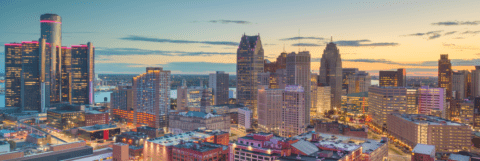That’s part of the reason why some are envisioning a pivot, adding more residential and public space to balance out the sea of offices that comprise downtown.
Last week, the Michigan Strategic Fund doled out $13.74 million in Revitalization and Placemaking Program money — which comes from the federal American Rescue Plan Act — to the DDP for eight projects, including a pair of residential real estate developments by Gilbert’s Detroit-based Bedrock LLC and Lansing-based Karp and Associates.
Those projects are:
- Placemaking enhancements to Cadillac Square next to Campus Martius Park.
- A pair of placemaking investments in the Paradise Valley Cultural and Entertainment District improving the central park and enhancing the entryway into the district.
- Grand Circus Park placemaking enhancements.
- Randolph Plaza improvements at the entryway into the Greektown neighborhood with permanent outdoor gathering space.
- Social district infrastructure in Capitol Park.
- Bedrock’s redevelopment of the Harvard Square Center building on Broadway Street.
- Karp and Associates’ redevelopment of the 1133 Griswold St. building.
It’s public space and residential projects like these, Larson said, that will help drive more residents and visitors downtown when the daytime office population continues to lag — and will for the foreseeable future.
Larson pointed to improvements at Grand Circus Park helping drive a broad strategy for the area.
“That community, especially as Related and Ilitch come together, is really starting to infill,” Larson said. “It’ll take some years, obviously, and it’s not going to be overnight, but the transformation of that park is going to take some time, too. Having a strategy about how the overall master planning of that park evolves with the surrounding neighborhood as it grows up is really critical.”
How landlords grapple with reduced office consumption remains up in the air, although some ways to help repurpose that space have been tossed around.
“I think we’ll see building owners start to get obviously more creative in terms of how they can utilize those spaces,” Larson said.
Federal legislation introduced last summer that would offer developers a sweetener to turn old office buildings into residential, institutional, hotel, or mixed-use space has floundered in Congress, sitting in the U.S. Senate Finance Committee.
If it becomes law, that could help drive additional residential inventory in a central business district that tends to lag behind the downtowns of other large metros.
For example, there are about 4,500 units in the downtown core, according to the DDP.
Yet four hours away in Cincinnati, a city with less than half of Detroit’s population, there are close to 18,000 residential units downtown, according to CoStar Group Inc., a Washington, D.C.-based real estate information service.
Detroit’s population is three-quarters of Columbus, Ohio’s but Columbus’ downtown has nearly 11,000 units. Cleveland has 300,000 fewer residents than Detroit within its limits but about 12,400 units in its downtown — nearly three times as many as Detroit, with another 1,000 or so in the hopper. Baltimore has 100,000 fewer residents but more than 15,000 units in its central business district.
So whether it’s finding new life for struggling office buildings, bringing more residents into the CBD and injecting new life and adding to public space and amenities, all will be crucial to a downtown still trying to find its footing in the pandemic.
“This 24/7 environment with residential and mixed-use is going to be really critical,” Larson said.


